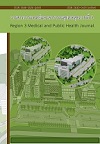Etiology and Outcome of Pediatric Status Epilepticus at Sawanpracharak Hospital
Keywords:
Status epilepticus, Children, Etiology, OutcomeAbstract
Objective : To study the etiology and outcome of children with status epilepticus (SE) and to evaluate the factors associated with unfavorable outcome.
Method : This is a retrospective analytic study. All patients with medical records age 1 month to 15 years old with SE admitted to Sawanpracharak Hospital, Nakhon Sawan, during 2011-2021 were studied. 122 patients were divided into 2 groups according to the outcome (favorable and unfavorable outcome). Multivariate logistic regression model was used to predict unfavorable outcome at discharge. A p-value of < 0.05 was considered statistically significant.
Results : 54.1% was boy and the median age was 3.2 years (IQR 1.1-6.3 years). 91 children (74.6%) had a favorable outcome, whereas 31 children (25.4%) had an unfavorable outcome. Overall mortality rate was 9%. Acute symptomatic (68.9%), remote symptomatic (16.4%), cryptogenic (10.7%) and progressive (4.1%) etiology were identified. Multivariate analysis revealed that unfavorable outcome was related to male (aOR, 4.49; 95%CI, 1.41-14.28; p=0.01), delayed development (aOR, 16.57; 95%CI, 4.12-66.74; p<0.01), SE duration > 5 hours (aOR, 6.58; 95%CI, 1.45-29.76; p=0.01), ≥ 4 anti-seizure medication (aOR, 10.24; 95%CI, 1.8-58.15; p=0.01).
Conclusions : Pediatric SE is highly associated with morbidity and mortality. The most common cause is acute symptomatic etiology. Children with pre-existing global delayed development or epilepsy should be aggressively treated. Early and effective treatment for termination of status epilepticus are the key factors to reduce morbidity and mortality.
Keywords : Status epilepticus, Children, Etiology, Outcome
References
Trinka E, Cock H, Hesdorffer D, Rossetti AO, Scheffer IE, Shinnar S, et al. A definition and classification of status epilepticus--report of the ILAE Task Force on classification of status epilepticus. Epilepsia. 2015;56(10):1515-23.
Alyoubi RA, Aljaafari DT, Basheikh MA, Al-Yahyawi NY, Bakry MA, BenHli NM, et al. The etiology and risk factors of convulsive status epilepticus in pediatric patients of tertiary center in Saudi Arabia. Neurosciences (Riyadh). 2021;26(1):26-30.
Halawa EF, Draz I, Ahmed D, Shaheen HA. Predictors of outcome of convulsive status epilepticus among an Egyptian Pediatric Tertiary Hospital. J Child Neurol. 2015;30(13):1736-42.
Cavusoglu D, Sinmaz EE, Dundar NO, Can FK, Anil AB, Sarioglu B. Treatment outcomes of pediatric status epilepticus in a tertiary pediatric intensive care unit. Pediatr Emerg Care. 2021;37(7):360-4.
Zimmern V, Korff C. Status epilepticus in children. J Clin Neurophysiol. 2020;37(5):429-33.
Visudtibhan A, Limhirun J, Chiemchanya S, Visudhiphan P. Convulsive status epilepticus in Thai children at Ramathibodi Hospital. J Med Assoc Thai. 2006;89(6):803-8.
Madhu PK, Krithika R. Convulsive status epilepticus in children: clinical profile and outcome in a tertiary care hospital. International Journal of Contemporary Pediatrics. 2019;6(2):280-7.
Vafee-Shahi M, Soltanieh E, Saidi H, Riahi A. Etiology, risk factors, mortality and morbidity of status epilepticus children: a retrospective cross-sectional study in Tehran, Iran. Open Neurol J. 2020;14:95-102.
Gurcharran K, Grinspan ZM. The burden of pediatric status epilepticus: Epidemiology, morbidity, mortality, and costs. Seizure. 2019;68:3-8.
Waesawat P. Etiology and clinical outcome of status epilepticus in children at Queen Sirikit National Institute of Child Health, Thailand QSNLIB: Queen Sirikit National Institute of Child Health; 2016.
Chetan C, Sharma S, Mathur SB, Jain P, Aneja S. Clinical profile and short-term outcome of pediatric status epilepticus at a tertiary-care center in Northern India. Indian Pediatr. 2020;57(3):213-7.
Chin RF, Neville BG, Peckham C, Bedford H, Wade A, Scott RC, et al. Incidence, cause, and short-term outcome of convulsive status epilepticus in childhood: prospective population-based study. Lancet. 2006;368(9531):222-9.
Nishiyama I, Ohtsuka Y, Tsuda T, Kobayashi K, Inoue H, Narahara K, et al. An epidemiological study of children with status epilepticus in Okayama, Japan: incidence, etiologies, and outcomes. Epilepsy Res. 2011;96(1-2):89-95.
Asadi-Pooya AA, Poordast A. Etiologies and outcomes of status epilepticus in children. Epilepsy Behav. 2005;7(3):502-5.
Chin RFM. The outcomes of childhood convulsive status epilepticus. Epilepsy Behav. 2019 Dec;101(Pt B):106286. doi: 10.1016/j.yebeh.2019.04.039.
Hommady RH, Alrifai MT, Mubayrik OK, Alayed RS, Alsemari MA, Arumayyan A, et al. Retrospective review of pediatric status epilepticus in 116 Saudi patients: predictors of outcome. Ann Saudi Med. 2017;37(6):455-60.
Kravljanac R, Jovic N, Djuric M, Jankovic B, Pekmezovic T. Outcome of status epilepticus in children treated in the intensive care unit: a study of 302 cases. Epilepsia. 2011;52(2):358-63.
Komur M, Arslankoylu AE, Okuyaz C, Keceli M, Derici D. Management of patients with status epilepticus treated at a pediatric intensive care unit in Turkey. Pediatr Neurol. 2012;46(6):382-6.
Kang DC, Lee YM, Lee J, Kim HD, Coe C. Prognostic factors of status epilepticus in children. Yonsei Med J. 2005;46(1):27-33.
Hussain N, Appleton R, Thorburn K. Etiology, course and outcome of children admitted to pediatric intensive care with convulsive status epilepticus: a retrospective 5-year review. Seizure. 2007;16(4):305-12.
Downloads
Published
How to Cite
Issue
Section
License
Copyright (c) 2022 เขต3 และโรงพยาบาลสวรรค์ประชารักษ์

This work is licensed under a Creative Commons Attribution-NonCommercial-NoDerivatives 4.0 International License.



